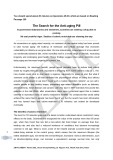
ISSN: 2615-9740
JOURNAL OF TECHNICAL EDUCATION SCIENCE
Ho Chi Minh City University of Technology and Education
Website: https://jte.edu.vn
Email: jte@hcmute.edu.vn
JTE, Volume 19, Special Issue 05, 2024
82
The Formulation of a Serum Containing Tomato (Solanum Lycopersicum L.)
Extract for a Green Anti-Aging Skincare Product
Van Quy Nguyen1, Thieu Phu Lau2, Thi Kim Chi Huynh3, Hoang Phuc Nguyen3, Thi Cam Thu
Nguyen3, Thi Hong An Nguyen3, Xuan Ngoc Nguyen3, Thi Kim Dung Hoang3, Anh Khoa Ton3*
1Ho Chi Minh City University of Technology and Education, Vietnam
2Ton Duc Thang University, Vietnam
3Institute of Chemical Technology, Vietnam Academy of Science and Technology, Vietnam
*Corresponding author. Email: kevinton150691@gmail.com
ARTICLE INFO
ABSTRACT
Received:
11/10/2024
Sunlight exposure can lead to photoaging that reduces the quality of life,
from inside to outside. Tomato contains a lot of nutrients and valuable
compounds which are powerful antioxidants. Hence, the utilization of safe
and effective natural compounds for the creation of phytocosmetic is
undoubtedly attractive for sustainable development. Herein, the small
pieces of tomato were dried at 60oC for 6 hours to remove the water. The
chloroform solvent was used for extraction by a 1:10 (w/v) ratio for 24
hours without light exposure. The yield was 0.273% compared with the dry
tomato. Besides, the total polyphenol and flavonoid contents were 111.49
± 0.31 μg gallic acid equivalents/mg extract and 150.15 ± 2.17 μg quercetin
equivalents/mg extract, respectively. The anti-aging serum containing
0.10% tomato extract was an ideal topically phytocosmetic that was stable
after physical evaluations, had no irritation by voluntary assessment as
well, and had a uniform diameter of O/W droplet around 40 µm with a
potential antioxidant for daily application. Therefore, we have formulated
an anti-aging serum containing tomato extract for nourishing the outside
beauty and taking care of inside health.
Revised:
13/11/2024
Accepted:
28/11/2024
Published:
28/12/2024
KEYWORDS
Anti-aging;
Tomato extract;
Polyphenol;
Flavonoid;
Green cosmetics.
Doi: https://doi.org/10.54644/jte.2024.1673
Copyright © JTE. This is an open access article distributed under the terms and conditions of the Creative Commons Attribution-NonCommercial 4.0
International License which permits unrestricted use, distribution, and reproduction in any medium for non-commercial purpose, provided the original work is
properly cited.
1. Introduction
Undoubtedly, aging is a complex process that is integrated into the development of life. In the aging
process, the excessive reactive oxygen species will be liberated from the living cells and implicated in
some accompanied aging diseases such as Alzheimer's and Parkinson's, schizophrenia, and so on [1].
Sunlight exposure is a means of aging that is induced by UV rays, one of the expressions is the signs
presented on our skin such as black pots, wrinkles, acne, and so on if we don’t take any preventive
actions, it will result in more serious damage to our health, the protection from outside will bring the
beauty and healthy for inside. Therefore, it is necessary to discover phytocosmetics that utilize natural
compounds for the safety and sustainability trends in the future.
Tomato (Solanum lycopersicum L.) is a daily and essential food source for humans because it has a
lot of valuable nutrients. Recently, the utilization of natural extraction has attracted intensive
investigations, especially phytocosmetics because the customers believe in the health of these products,
not only for humans but also for our environment. Tomato contains polyphenolics, flavonoids, saponins,
carotenoids, monoterpenoids, and sesquiterpene. Lycopene is a component of a carotenoid compound
that owns 11 conjugated double bonds to express the potential antioxidant capacity by a high quenching
rate for singlet oxygen [2], [3]. Regarding the importance of lycopene, it is reported that lycopene can
protect the skin from the photoaging induced by UV rays [4], prevent cardiovascular disorders [5], and
have protective effects in anti-inflammation and anticancer [2], [6].
In this research, we developed an anti-aging serum containing tomato extract to exploit potential
products for a green skincare era. The total phenolic and flavonoid compounds will be determined, and
the antioxidant of the extract will reflect the ability of the bioactive in the phytocosmetic, besides, the







